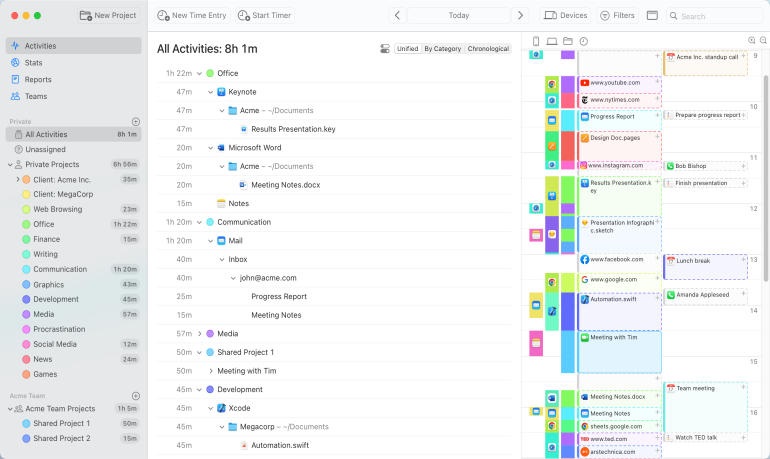14 Tips for Juggling Multiple Freelance Projects

Juggling multiple projects is one of the biggest challenges for many freelancers. It starts when one client decides to expand their services. Then another wants an extra project. Then someone refers you to their friend and they want a one-off job. Now an agency wants to subcontract through you. All of a sudden you’re busier than ever!
What makes this hard is that your clients don’t know each other. They don’t know, or care, but you have other obligations. They only know what you promise to deliver.
Keep in mind that having lots of work is a good problem to have. It means you are doing something right as a freelancer. People want to work with you, so your career is on the right track.
If you don’t find ways to manage multiple projects, there’s a good chance you’ll fail to meet your obligations. Clients will be dissatisfied if you deliver poor-quality work or submit it late. It could affect your relationship with those clients and your overall reputation.
So for the sake of your income and your career, it’s important to learn how to manage a busy workload.
If you don't find ways to manage multiple projects, there's a good chance you will fail to meet your obligations. Share on X
14 Freelance Tips for Juggling Multiple Projects
Your job is to not only deliver your projects on time, but still maintain the high level of performance and quality of work that your clients expect. The following tips will teach you how to juggle multiple freelance projects so that your clients are happy, your income increases, and you don’t lose your sanity.
1. Set aside time to plan your week

When you have a lot of projects on your plate, keeping them organized can be a challenge. It helps to set aside a small block of time each week to create a plan. You do your planning Monday morning for the current week or Friday afternoon for the next week. This should not take more than fifteen minutes.
During your planning session, review your upcoming task list. Break it down by day if you can. Look for any problems that might appear during the week so you can take steps to solve them soon.
2. Prioritize based on needs and deadlines
When you plan tasks and projects, organize them based on needs and deadlines. Consider the optimal way to work to get everything done on time by looking at your work holistically.
For instance, let’s say you have a project due tomorrow for Client A. You also have a project for Client B due next week, but this project requires some information from another person. Even though Client A’s project is due sooner, it’s smart to reach out to the other person for Client B’s project. This way that person has some time to supply their information before you need it.
Furthermore, consider how your clients, partners, and associates work. Do they respond quickly? Do they submit their collaborations early or right at the deadline? Do they need a lot of communication? Answering these questions will help you build a schedule that accommodates all of the variables of freelance work.
3. Track your time with detail
If you are juggling multiple freelance projects at the same time, it’s important to get a clear understanding of how you are spending your time and whether you can make any improvements. So you will want to track your entire work schedule, minute by minute, in a manner that lets you look back and evaluate yourself.
Obviously this is impossible to do manually, so you will need time tracking software. These tools give you a clear picture of your time so you can optimize and refine.
Ideally, you should use automatic time tracking software like Timing. Timing records your time automatically without pressing “start” or “stop” timers. Timing’s smart timeline shows you exactly what you did at any given time, including which app, document or website you were using.

Furthermore, you can assign clients and projects to their own categories to keep yourself organized. When you are finished, use Timing’s dashboard and reporting feature to get a great overview of how your time is distributed across your apps and projects.
Start your free trial of Timing today.
4. Be realistic with your deadlines
It’s tempting to promise quick turnarounds with your projects, which may delight your clients and help you close deals, but often creates too much pressure on your schedule. Aggressive deadlines aren’t just stressful. They can have a real impact on your income if you can not meet them.
Think about your projects in the context of your overall workload. If you already have several large projects on your plate, give yourself more time. For instance, it may only take you a week to design a website, but it’s okay to ask for three weeks if you have other websites in your queue. This holistic approach to project management is key to avoid overextending.
Don’t be afraid to set generous deadlines with clients. If it will take five weeks, so be it. It’s better to be honest with your clients than a) disappoint them when you miss the deadline, or b) work yourself to death.
5. Leave a bit of space in your schedule.
As a freelancer, it’s important to understand the concept of opportunity cost. This refers to the loss of potential gain from alternatives when you make a choice.
You have probably been in a situation where a high-paying job came your way, but you couldn’t take it because you already had a full load of work. This is the main drawback of having a full schedule.
But not all projects are equal. Some are more valuable than others, in terms of income and connections. For example, one project may pay $700 for eight hours. Another might pay $700, but for only three hours due to the requirements for the project. So it helps to leave a bit of room in your schedule every week for high-value projects that you definitely don’t want to turn away.
You can also use this extra space for overflow projects. If a project takes a bit longer than you expected, you can use your overflow space to complete it without stressing yourself out or jeopardizing other projects.
6. Work on one task at a time
Interestingly, humans are bad at multitasking. We like to think we can do multiple things at once, but this type of work forces our brains to constantly re-adapt, which ruins our performance. Experts say it takes 23 minutes and 15 seconds to re-focus on a task after being interrupted. When we try to do everything, we end up doing nothing well.
Instead, it’s better to focus on one task at a time and make your transitions deliberate. For instance, if you need to design a landing page, put everything else aside until the page has at least the initial design. Then you can take a break, check your email, chat with a client, or review your bookkeeping. After the interruption, shift into editing mode for your landing page and do not stop until you are done. This practice is called time batching.
(Oh, and stop watching Netflix while you work. You know that’s distracting!)
7. Check in on each project at the end of the day
Everyone falls behind sometimes, but it’s important to catch these stumbles before they become bigger problems. Otherwise little problems can turn into bigger problems quickly.
Spend just a couple of minutes – no more than five – at the end of each day to check on projects. Is your plan progressing properly? Do you need to modify your plan for the next day? Do you need to check in with a client or ask them for clarification? These are important questions to mentally ask each day to stay on track.
This is also a good time to quickly review your time tracking software. Did anything take longer than it should have? Did you fail to address a task or project that you planned to complete? Will how you spent your time affect your billing?
8. Set reminders for important tasks
If something has a hard deadline, it absolutely deserves a reminder. Don’t rely on your memory or your ability to check the clock. There are countless tools available to manage this for you, from the clock app on your phone to more sophisticated tools.
What kinds of tasks should you set reminders for?
- Due dates and deliverables
- Meetings and meet ups
- Irregular tasks, like invoicing or filing taxes
- Check-ins with clients and partners
- Timing reminders (e.g., “You should be 50% complete by now.)
When you create a reminder, make sure to write as much detail as you need to understand what the reminder is about. Often the client’s name is enough to jog your memory. For instance, a reminder for “meeting” is unhelpful, but “meeting with David Smith” or “meeting with Acme Design” is usually sufficient.
9. Set communication boundaries with clients

Some clients want to communicate a lot. In some cases, they have a lot of information to share and want you to have it right away. In other cases, they are anxious about hiring a freelancer and want constant assurance that you are working on their project.
But repeated interruptions (like the need to constantly answer phone calls and emails, or the need to attend frequent video meetings) get in the way of actual work, especially when juggling multiple projects.
How do you overcome this? By setting boundaries. Let your clients know when you return emails or phone calls (beginning of the day, end of the day, at lunch, etc.) in your initial discovery calls. Tell them you are not available at a moment’s notice. Don’t answer during your head-down work periods of the day.
There are two exceptions here. First, you have to respond to the client if you promised them that you would be available. (Hopefully you charged for this service!) Second, respond if you think the client may be calling about an emergency that would greatly affect either of you.
10. Use a project management tool
One of the most important freelance tips we can give you about juggling multiple projects is to keep yourself organized. This tip will do the most to help you navigate your diversified workload.
If you aren’t already, use a project management tool like Trello, Asana, or Monday. These tools give you a place to lay out and organize your projects, tasks, and sub-tasks. You can even invite other freelancers to your projects if you need to collaborate.
The beauty of a project management tool is that it takes everything out of your head. You don’t have to worry about the dozens of little steps to complete each project. Just add them to your project manager, set deadlines (if necessary), and then focus on them one at a time. When you complete a task, find the next one.
11. Don’t be afraid to ask for extensions
If you don’t think you can complete a project on time, your last resort is to ask for an extension. Obviously this isn’t ideal, so do everything in your power to avoid it, but this approach is better than failing to deliver your work or not saying anything to the client.
If you need to ask for an extension, do so as soon as possible. Give the client as much notice as you can. Do not wait until the night before the due date to speak up.
This is another reason time tracking is so important to juggling multiple freelance projects. It helps you anticipate how much time your work will take based on how much you have spent so far. This way you’ll have ample opportunity to notify the client.
When you ask for an extension, explain your situation honestly with the client. Most will sympathize and give you the time you need. But it helps to offer something of value to make them more receptive to the extension, like an extra service, more options, a fee reduction, etc.
12. Say no to new projects
It’s hard to decline a project, especially when there’s good money on the line. But if you are struggling to balance all of your obligations, sometimes saying no is your best solution. This is especially important if you worry that taking on a new project would compromise your ability to fulfill your existing obligations.
When you decline a new job, be sure to explain that you are just too busy to do it well and you would hate to deliver poor work. Ask if they have any flexibility in the deadline, at a point where you have more time. If they can’t wait for you, explain that you would love to work with them in the future.
13. Outsource when you are overwhelmed

Freelancing is a feast-or-famine lifecycle. Sometimes there’s just too much work to handle. You don’t want to decline, because turning down money is hard and that client might go work with someone else. But you know you can’t handle all of it.
A great freelance tip in this case is to outsource. Look to your network for other qualified freelancers who perform great work. Ask them to complete the job for you so it’s no longer on your plate. There are two ways to compensate the outsourcer:
- Pay them whatever you charge for the job. You will not make any money, but you’ll still keep the client. The client won’t go to another freelancer. When they need help again in the future, they will come back to you (and hopefully you will have room in your schedule).
- Pay them a little less than you charge. In this case, you can make a small amount of money. After all, it’s your client and you still have to do some work ferrying the project between the two parties. Keep in mind, however, that the outsourcer may do a smaller, faster, or cheaper job because they are being paid less.
Some freelancers like to barter services. They say, “Write this article for me this week and I’ll owe you an article sometime later.” Sure, it’s simple, but you may not be available to repay your outsourcer when they need it. We do not recommend this method. Just pay for the work.
Now, when you outsource a project, be sure to transfer the details and requirements carefully. Make it clear that you expect to see the same quality of work that you typically deliver. Show examples of past work if you can so the output matches.
14. Take mindful breaks
It seems counterintuitive, but breaks are a key part of work. You aren’t a machine that can work indefinitely. If you become overworked because you are juggling too many projects, an important freelance tip is to step away from your computer and take a break. This is important not just for your work productively and your ability to handle multiple clients, but also for your work-life balance and general happiness.
A break does not mean checking email, reviewing notes, or thinking about work while you eat quickly. It means separating yourself from work entirely. Do something else with your brain while you relax. Or do nothing. But don’t do work.
Most importantly, don’t just take breaks when you feel burned out. You may feel the need to work yourself to exhaustion, but those kinds of breaks are not as effective. Schedule regular breaks throughout your day and at least one non-work day. Take your breaks even if you are busy. This way you are maintaining your mental health, rather than responding to emergencies.
Wrap Up
Juggling multiple clients can be tough, especially if you’re new to freelancing or if your business is starting to grow. But if you follow the collection of freelance tips we outlined above, you will be able to plan well, execute your to-do list, and keep your projects flowing.
If you are struggling to balance your client load, we strongly recommend installing an automatic time tracking app to help you get a better picture of how you are spending your time. Only once you know where you are making mistakes can you take steps to fix them.
